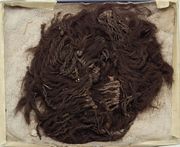Difference between revisions of "Human hair"
Jump to navigation
Jump to search
| Line 14: | Line 14: | ||
<gallery> | <gallery> | ||
File:humanlarge.jpg|Human hair | File:humanlarge.jpg|Human hair | ||
| − | File:03 Caucasoid Head hair 200X_comp.jpg| | + | File:03 Caucasoid Head hair 200X_comp.jpg|Caucasoid Head hair at 200x |
| − | File:03 Caucasoid Head hair 500X adj.jpg| | + | File:03 Caucasoid Head hair 500X adj.jpg|Caucasoid Head hair at 500x |
| − | File:01 Mongoloid Head hair 500X_comp.jpg| | + | File:01 Mongoloid Head hair 500X_comp.jpg|Mongoloid Head hair at 500x |
| − | File:02 Negroid Head hair 500X_comp.jpg| | + | File:02 Negroid Head hair 500X_comp.jpg|Negroid Head hair at 500x |
</gallery> | </gallery> | ||
Latest revision as of 17:22, 9 September 2022
Description
Hair primarily grown from the scalp of humans (Homo sapiens). Human hair is a cylindrical tube composed mostly of Keratin. The shaft is covered with thin, flat scales and the central core often contains pigments of red, black, or brown. Commercially, human hair has often been used for wigmaking. A small amount of long, black, human hair has also been used for brushmaking.
Physical and Chemical Properties
Growth rate = 1 cm/month
Human hair is strong (a single strand can hold 100g)
Additional Images
Resources and Citations
- Encyclopedia Britannica, http://www.britannica.com Comment: hair" [Accessed October 16, 2003].
- Zora Sweet Pinney, 'A Handle on the Terms used for Artists' Brushes', unpublished glossary, 1999
- Wikipedia: http://en.wikipedia.org/wiki/Hair (Accessed Nov. 9, 2005)
- The American Heritage Dictionary or Encarta, via Microsoft Bookshelf 98, Microsoft Corp., 1998






